Last month, as Penny and I drove down through the eastern states to South Carolina to spend a couple of weeks in Hilton Head, it became obvious that the billboards we were passing told a revealing story about American culture. It many ways it was also a significant contrast to our Canadian version of culture.
So on the way home I tried to take photos of them as we drove. This blog is a photographic record of these billboards and my observations.
Lawyers: Canada’s mostly buttoned-down profession is bound by strict rules on advertising so it’s interesting to look at how their US counterparts promote themselves. This first one is my favourite billboard of them all: “Life is short. Get a divorce” from the Anderson Law Firm. What clever marketing: divorce for happiness!
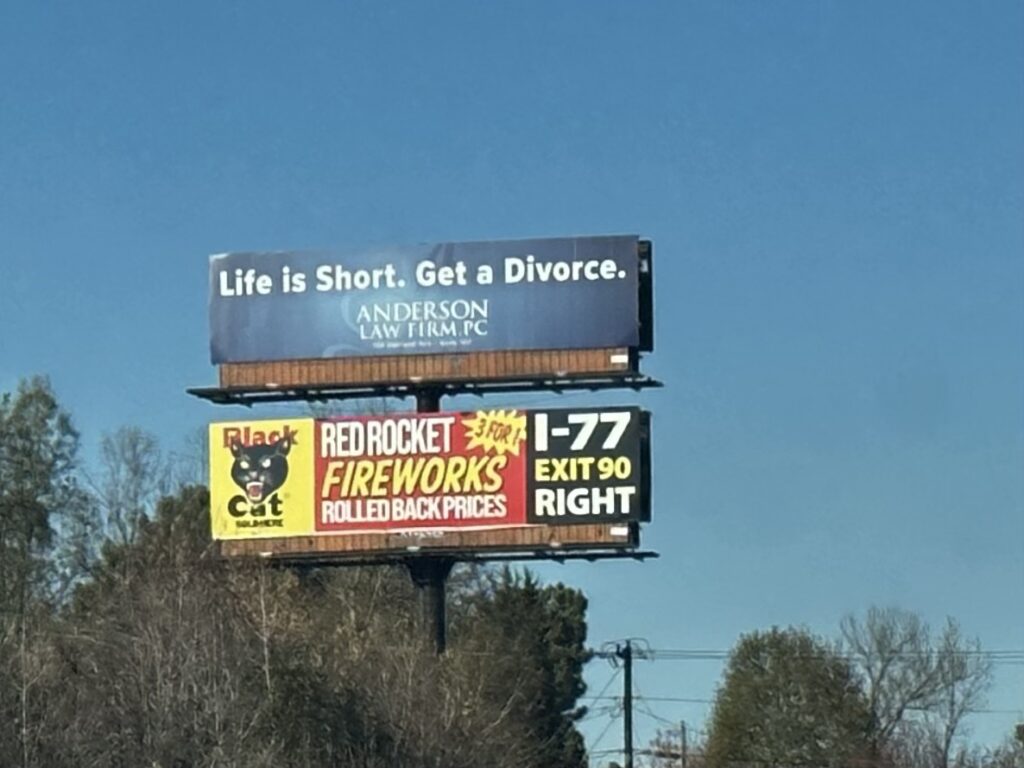
Then there is the “In jail. We bail”, offering “24 hour service from St. Choice Bail Bonds”. There is no commercial business of bail bondsman or bail insurance in Canada. Bounty hunting is not accepted in Canada while it is common practice in some parts of America. Most people in Canada would consider bounty hunting as completely immoral and wrong.
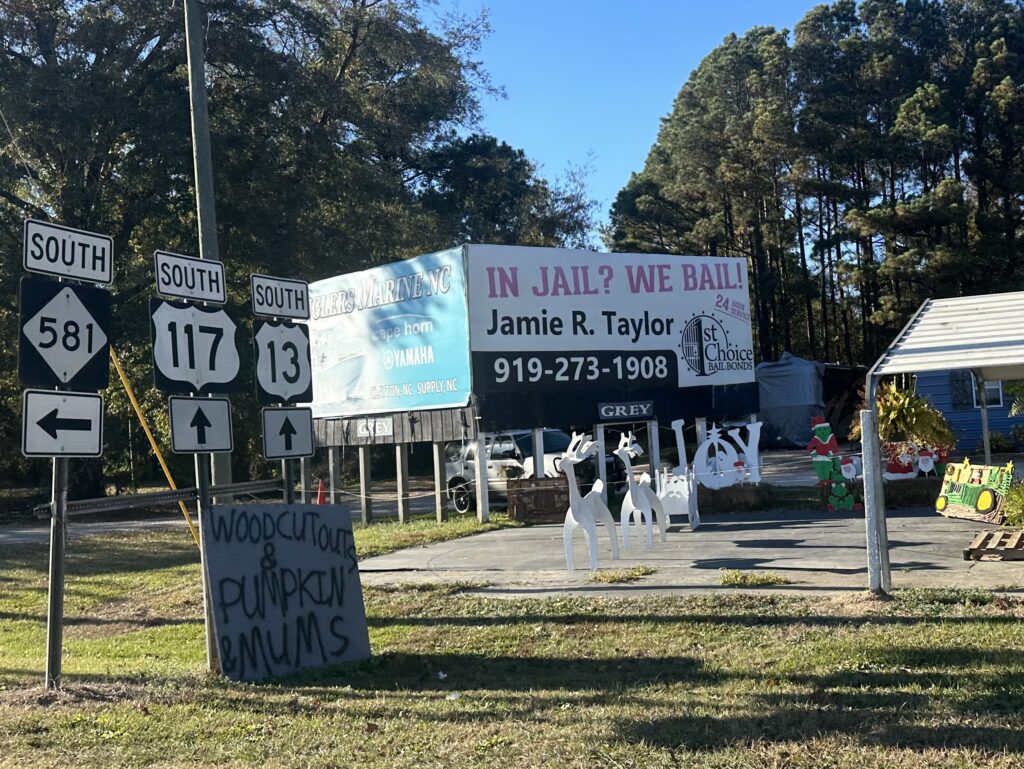
The “In Pain. Call Shane” from the Shane Smith Law company in Charlotte, NC doesn’t indicate how the pain might have been inflicted (car accident; marital difficulties; food poisoning?), so I’m confused as to who his audience might be.
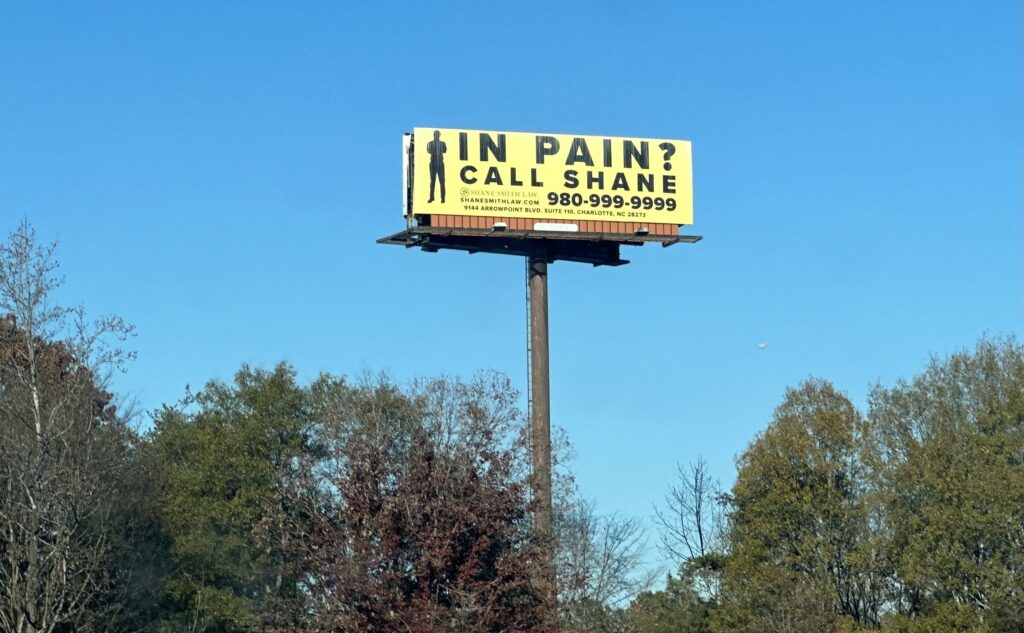
The specialist legal team of Farmer Cline & Campbell offer up a “truck accident team”. Now that’s tightly focussed.
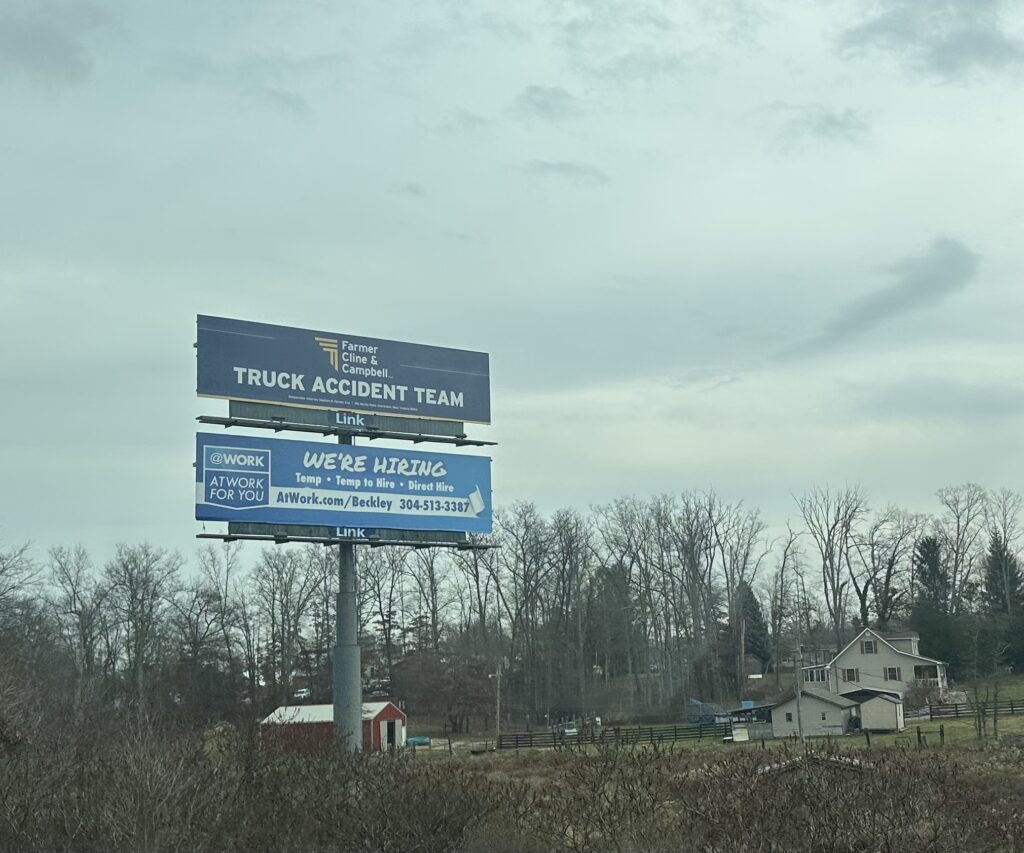
Then Gerald Hayden of Hayden & Associates wants to talk about a variety of his specialties “Divorce & Custody. Car Wrecks. Criminal. Traffic Tickets”. Wouldn’t he be delightful sitting next to at the dinner table?
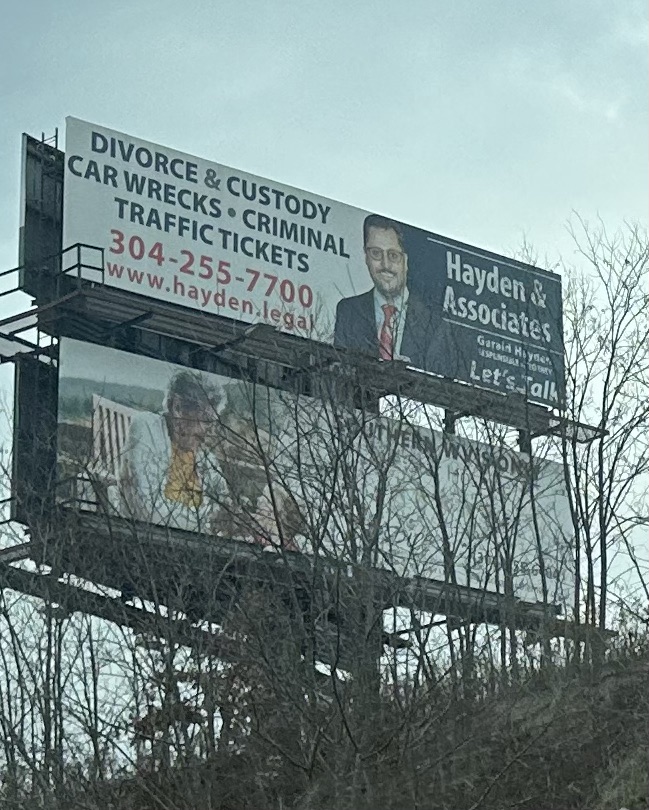
Public service: Quite a wide range of public service messages were presented along the highways. “Make sure they’re in the right car seat” is a message from The National Highway Traffic Safety Administration promoting the use of the correct car seat for your kids.
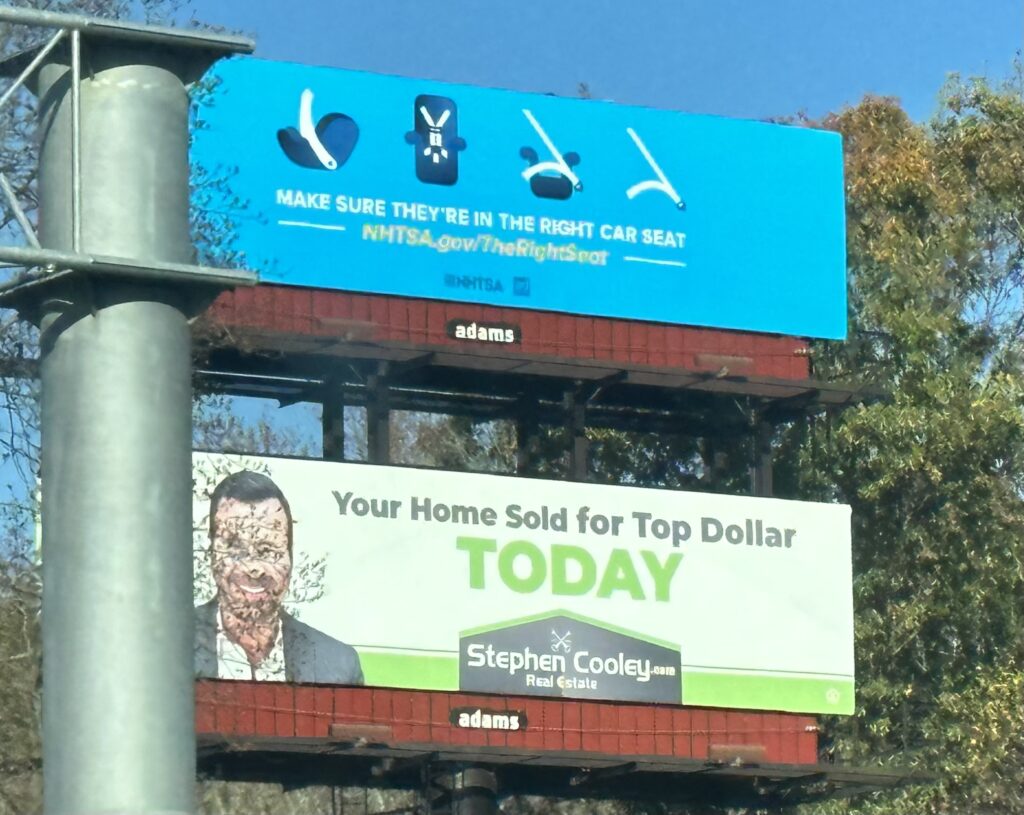
Or “Want to stop drinking? We can help” Go to “CharlotteAA.org“. Same purpose as in Canada: stay sober.
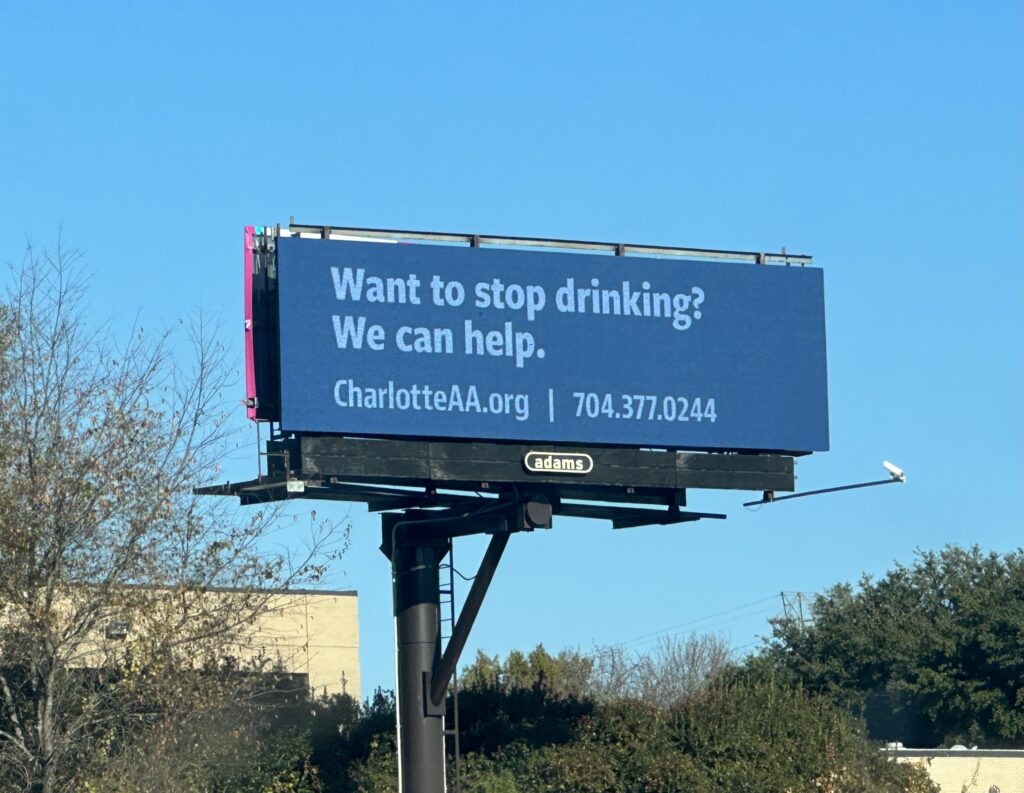
Here is dandy one: “The next disaster is coming. Get ready now.” Do they have in mind Trump in a second term? It’s sponsored by Americares, a global non-profit organization focused on health and development that responds to individuals affected by poverty, disaster, or crisis.
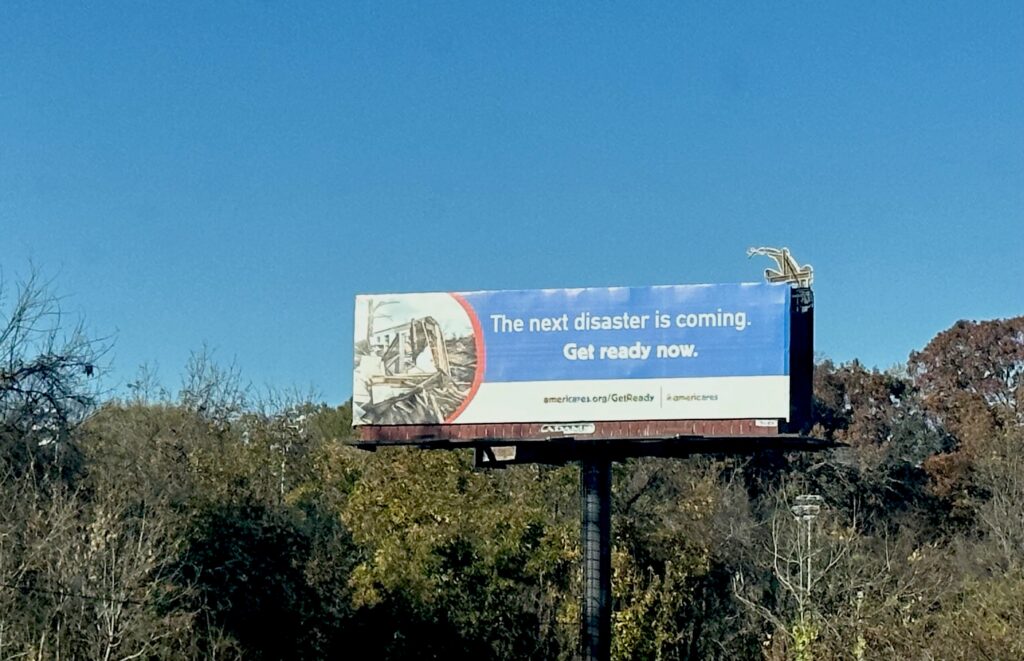
A double-barrelled couple of boards offer, in the top one, “Support more victories for veterans” (promoted by DAV or the Disabled American Veterans, an organization created in 1920 by World War I disabled military veterans of the United States Armed Forces). Below it a billboard cautions one regarding cell phone use (“One text or call could wreck it all”. “Put it down. Save a life.”).
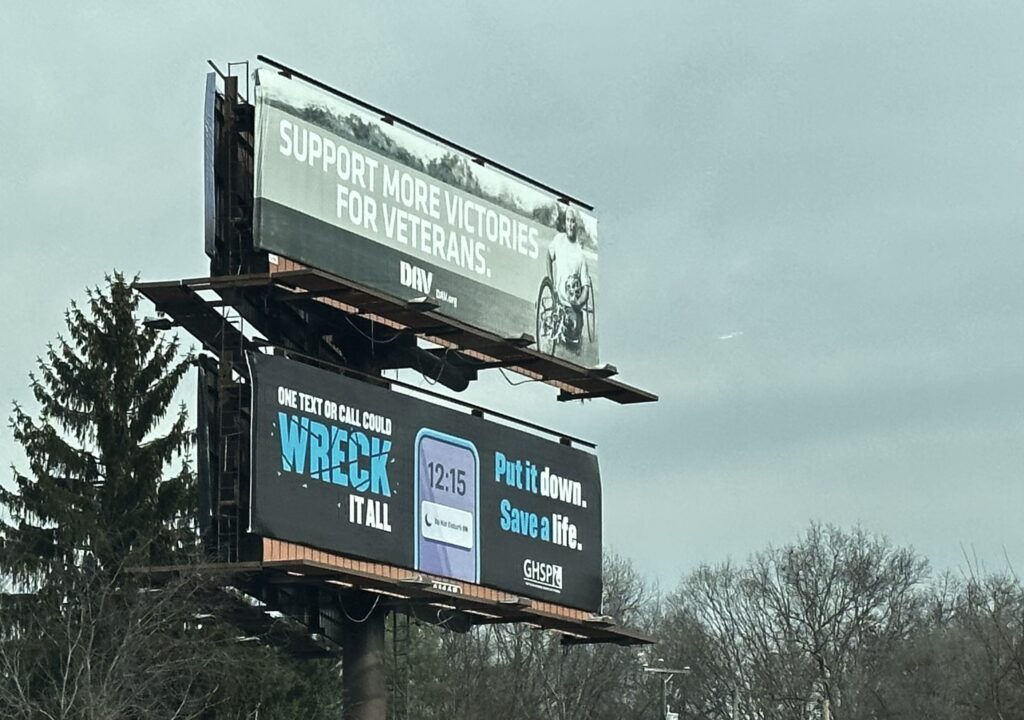
Veterans. You are not alone” is the reassuring message from “VA.GOV/Reach”. We have our Veterans Affairs Canada who don’t do billboards.
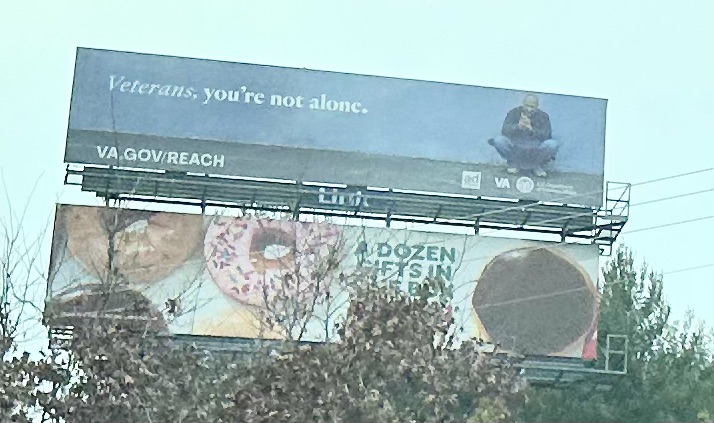
Fireworks are big, and promoted everywhere: “Flashes. Fireworks – last chance for low prices”; turn right at Exit 77.
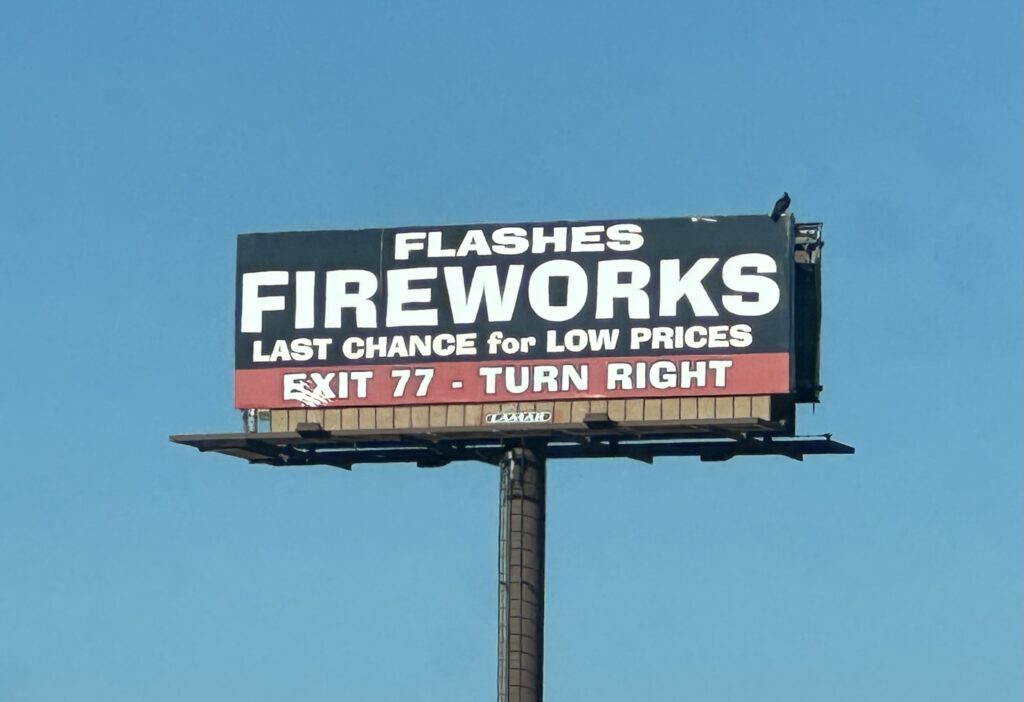
Or “Redrocket fireworks. Rolled back prices.” (They sell Black Cat, which is the oldest registered consumer fireworks brand in the US.)
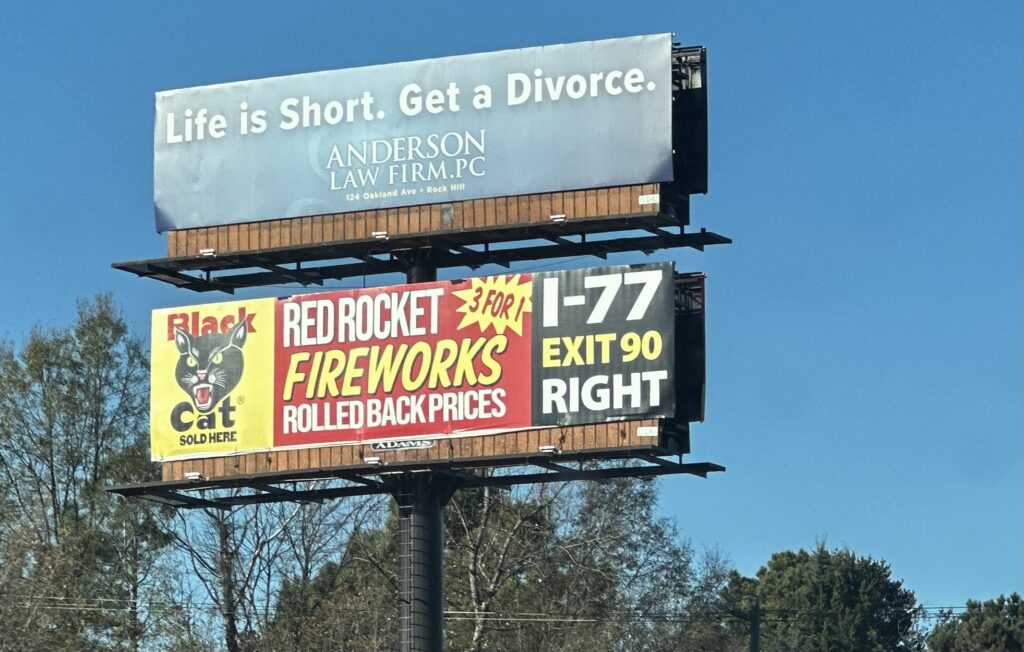
The “Area 51 Fireworks” with the green Martian creature might greet you when you “turn left at the light after Exit 90”.
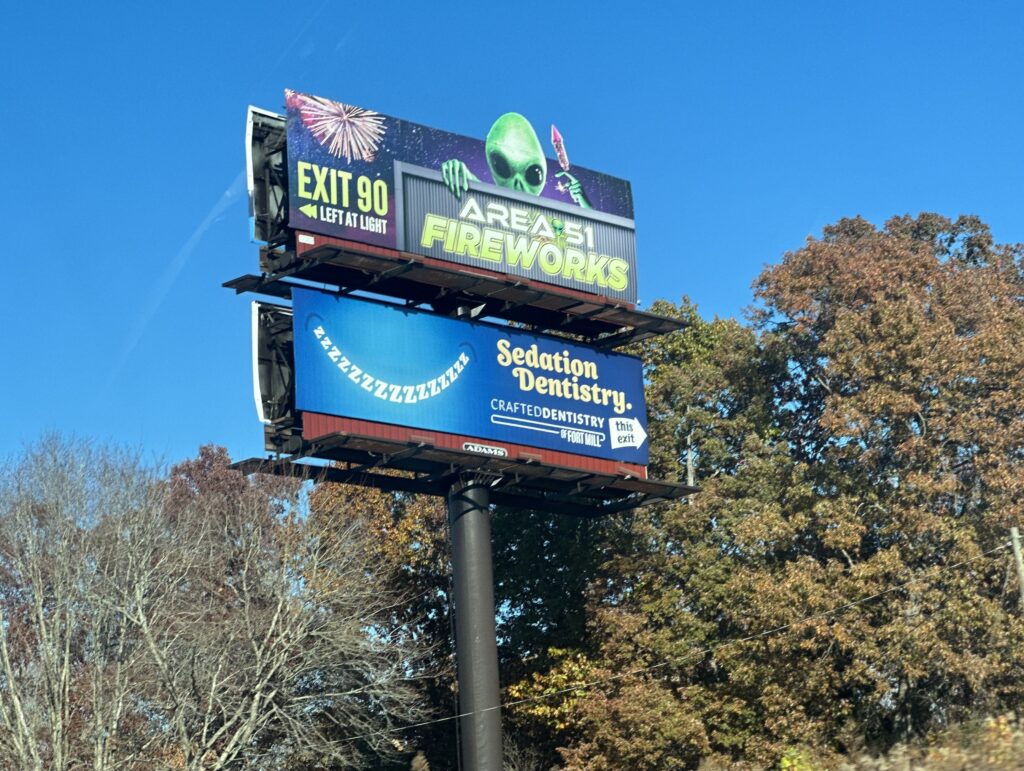
Medical; dentistry: Canada’s public hospitals are unlikely to promote their existence; they would like fewer clients if possible. But in the US, it’s big business, private, and the source of profit – so, market them they do. So we have the promotion of a new hospital: “Atrium Health, Lake Norman. Coming soon”.
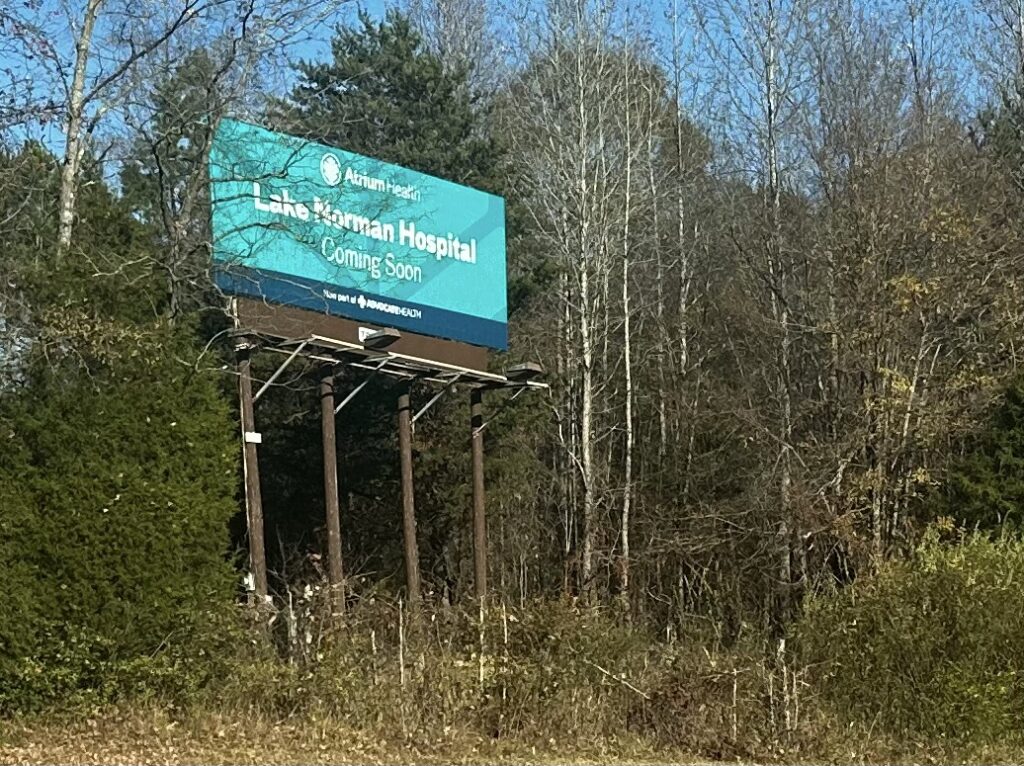
Or promotion of primary care is offered at the Charleston Area Medical Center for Oak Hill, Fayetteville and Beckley. (You can get a good steak after visiting, at the Fukiyama Japanese Steak House.)
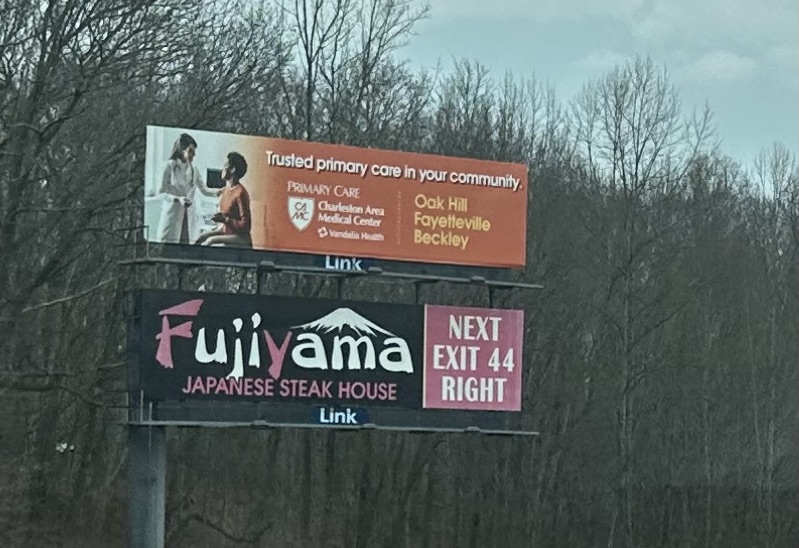
Who can refuse three hospital gowned medical professionals who are identified as “Trusted Surgeons Now Taking Referrals in Princetown” at WVUMedicine.
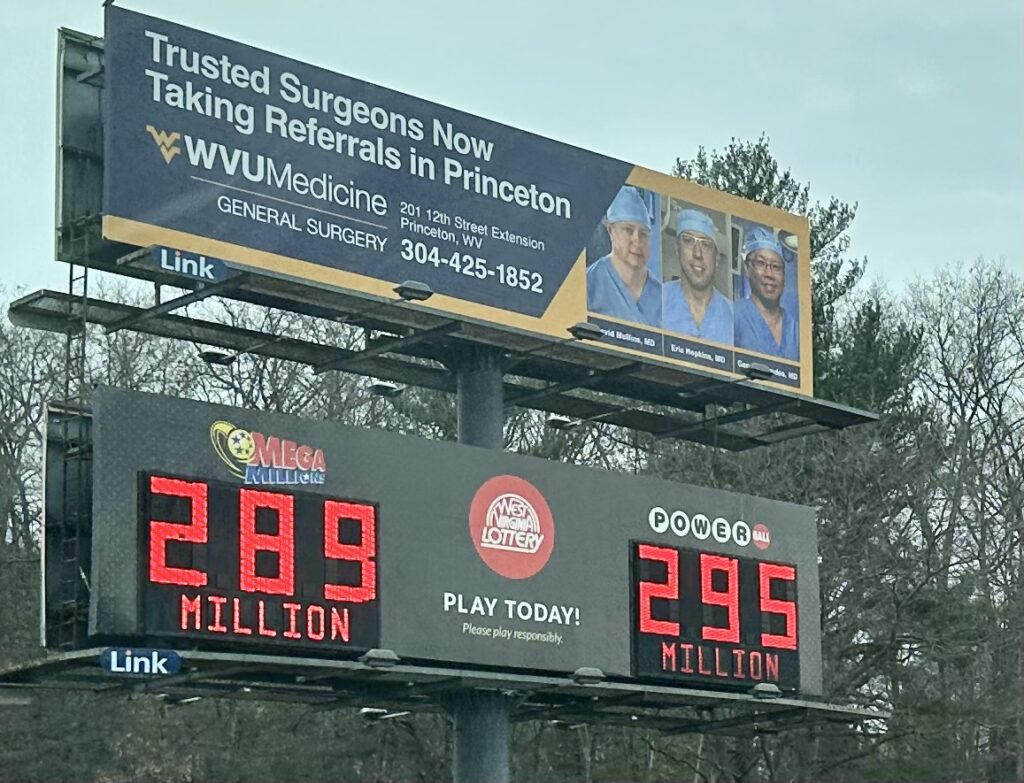
A lot of specialty procedures are offered. If you have plumbing problems you can “Stop the pee” at exit 33 (note the rhyme) by visiting one of the “Stay Dry Med Centres”.
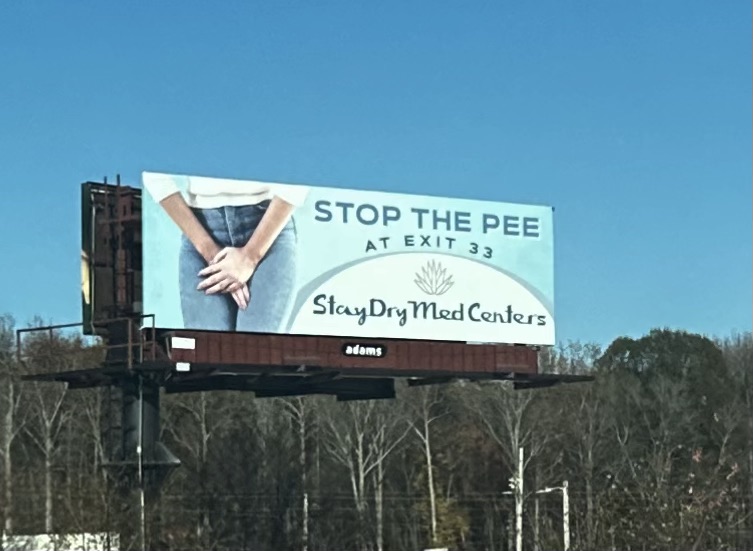
Stop in Huntersville for “Plastic surgery. Dermatology. Skin cancer care”. (The quest of Piedmont Plastic Surgery & Dermatology is to “bring you the most comprehensive cosmetic and dermatologic care in the nation.”)
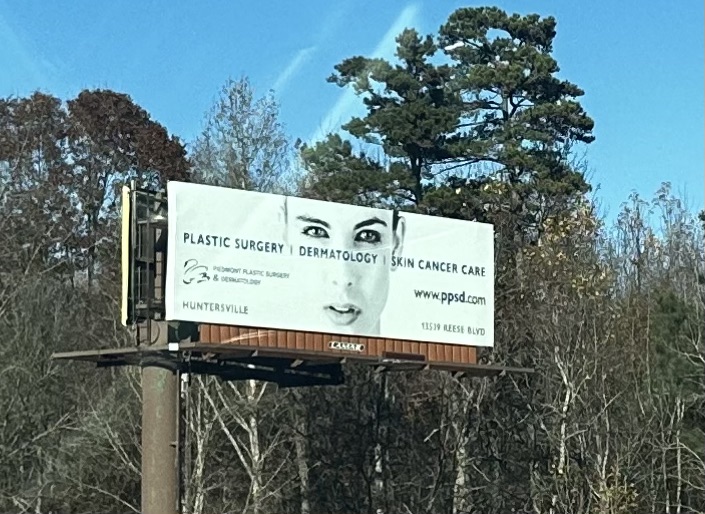
A double offering is available around New River: “Orthopedic Care Close to Home” at WVUMedicine” and just below it “OB/GYN Patients Now Welcome” at New River Health in Summersville.
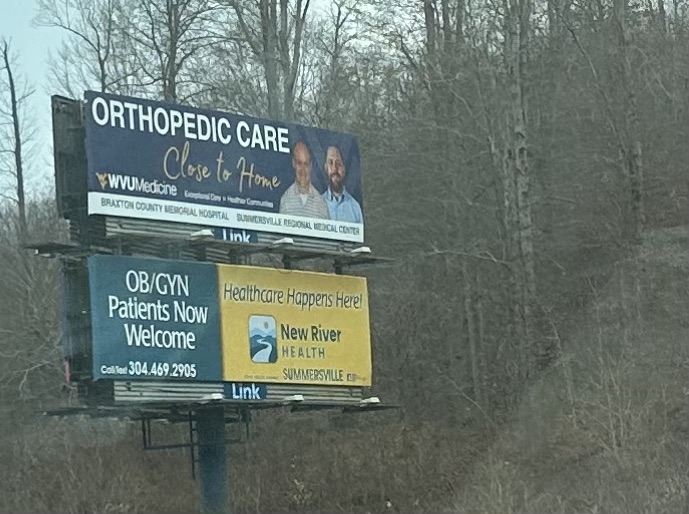
Sedation Dentistry zzzzzzzzzzzz from Crafteddentistry of Fort Mill, available “this exit” sounds quite relaxing. I think I’ll just pull off and take a break.
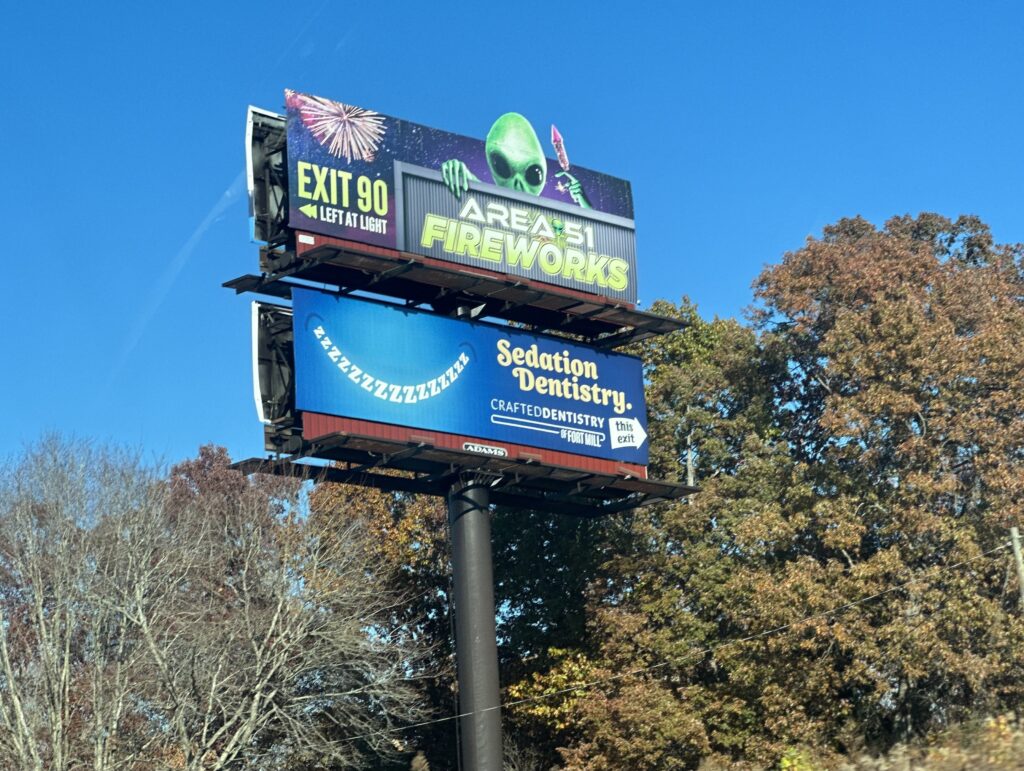
Religious: In bold yellow the plea sings out over the highway “Forgive my sins JESUS. Save my soul”. This is directly below the “We come to you” law firm run by Glenda Mitchell that helps you when you are injured (perhaps thinking of your sins or even after you have been to one of those promoted hospitals).
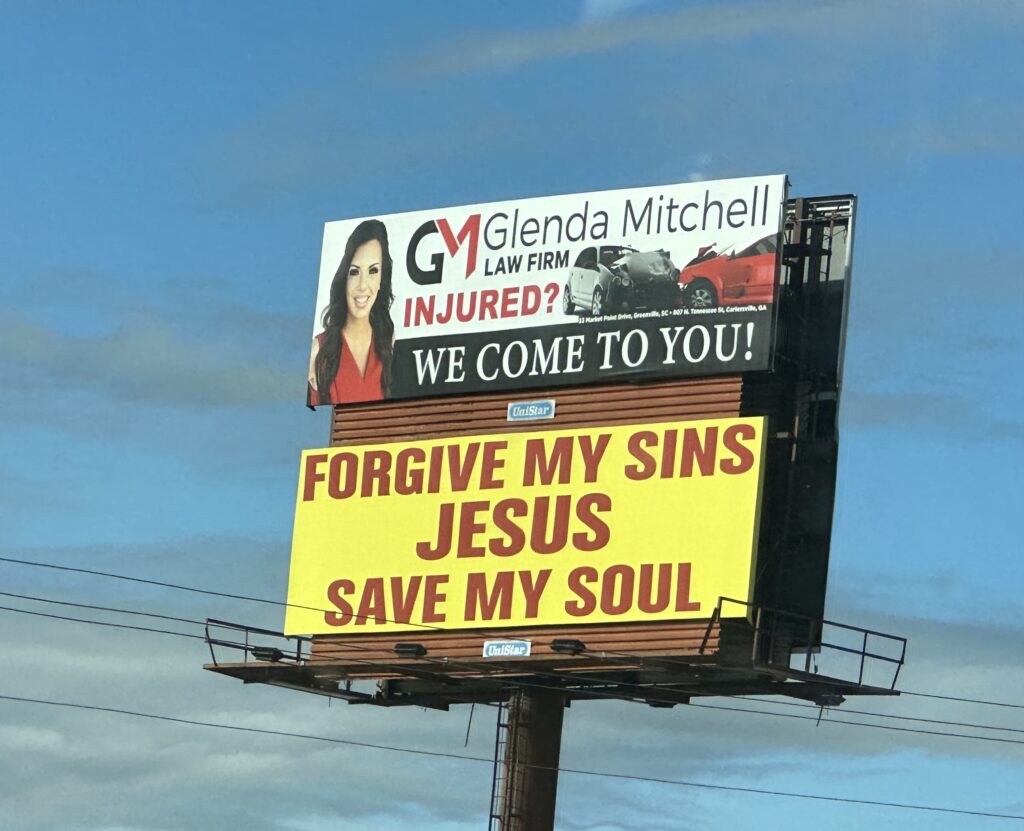
Another double billboard tantalizes with the top one declaring “Jesus offers you” and holding my breath I glance below with the fulfilling answer of “a new life”. Note the suggestion one call 83-THE TRUTH. I passed.
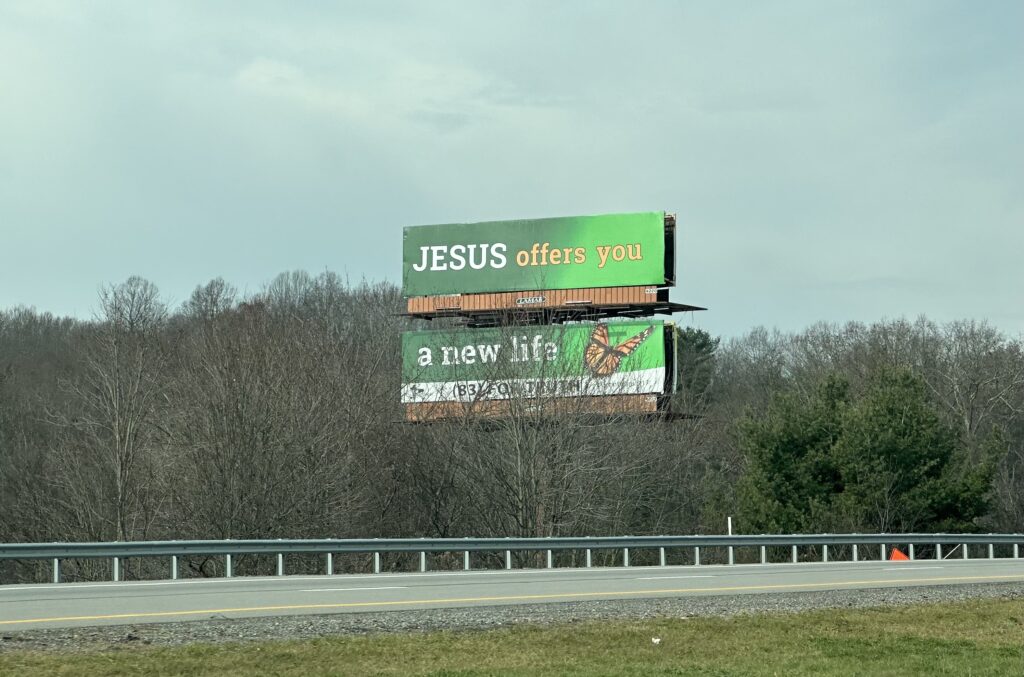
In quite a juxtaposition, Mohawk Power Sports at Beckley sits below three websites you may want to visit (bibleinfo.com, helltruth.com” and sabbathtruth.com“). I did; you have to too – the helltruth one is scary.
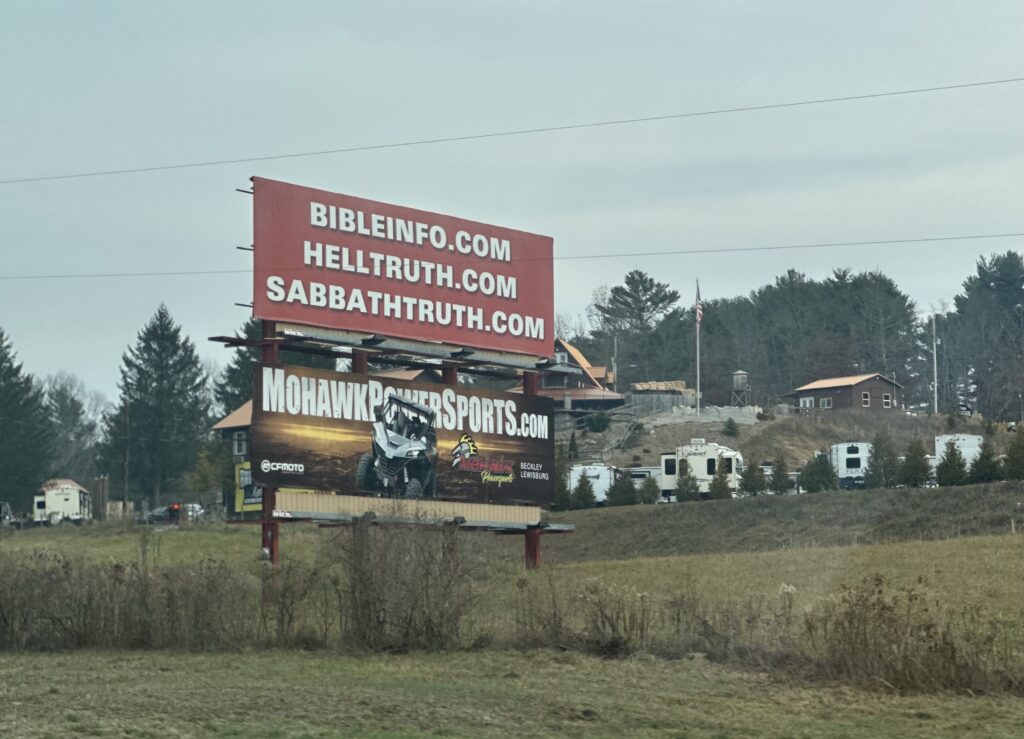
One billboard instructed me to “Prepare to Meet Thy God” (at beingsaved.org; however that page has been removed from the internet so don’t bother). I’m not sure what to make of the subtitle on the billboard which stated “Behold I come quickly”; I’ll just leave it at that.
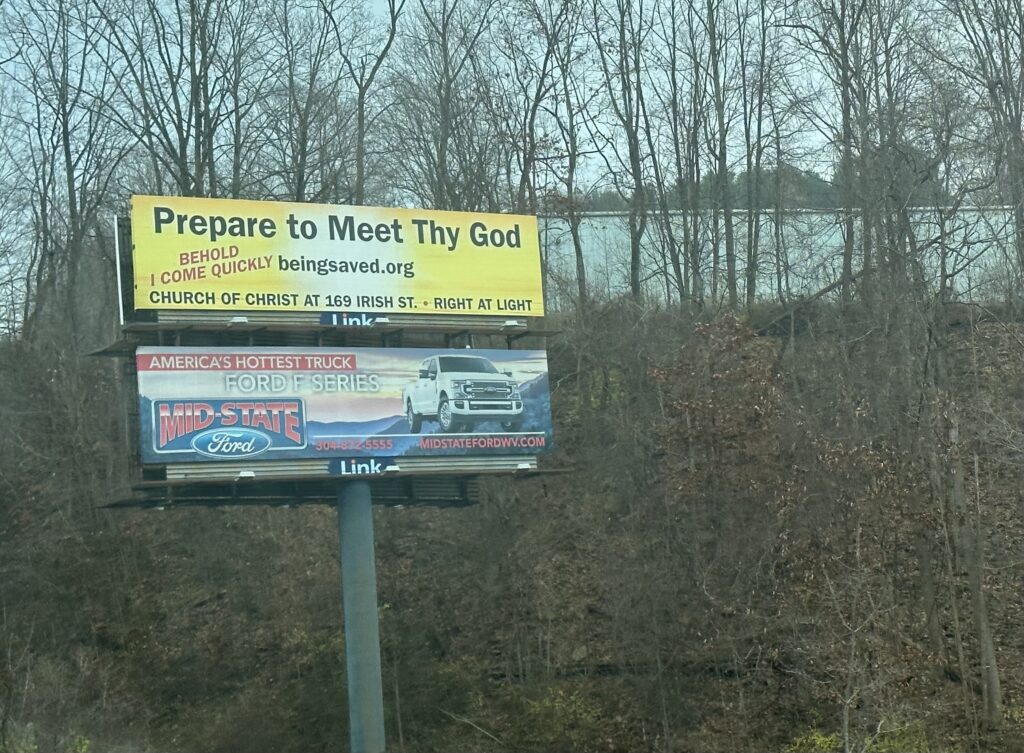
We passed a few more “Jesus Saves” and some anti-abortion ones I was not quick enough to capture (or was driving). Also, I chickened out photographing a young lady one evening with a “Call for Jesus. He never leaves” sweat shirt on, although the act of wearing it sort of means she wanted it to be seen and reckoned with.
Real estate: “Guaranteed cash offer on your home”. I think so; it would be highly unlikely NOT getting a cash offer using this beatific, eager looking, real estate salesman. Later up the highway we learned we can move quickly in to a Dogwood Grove home from the $400s.
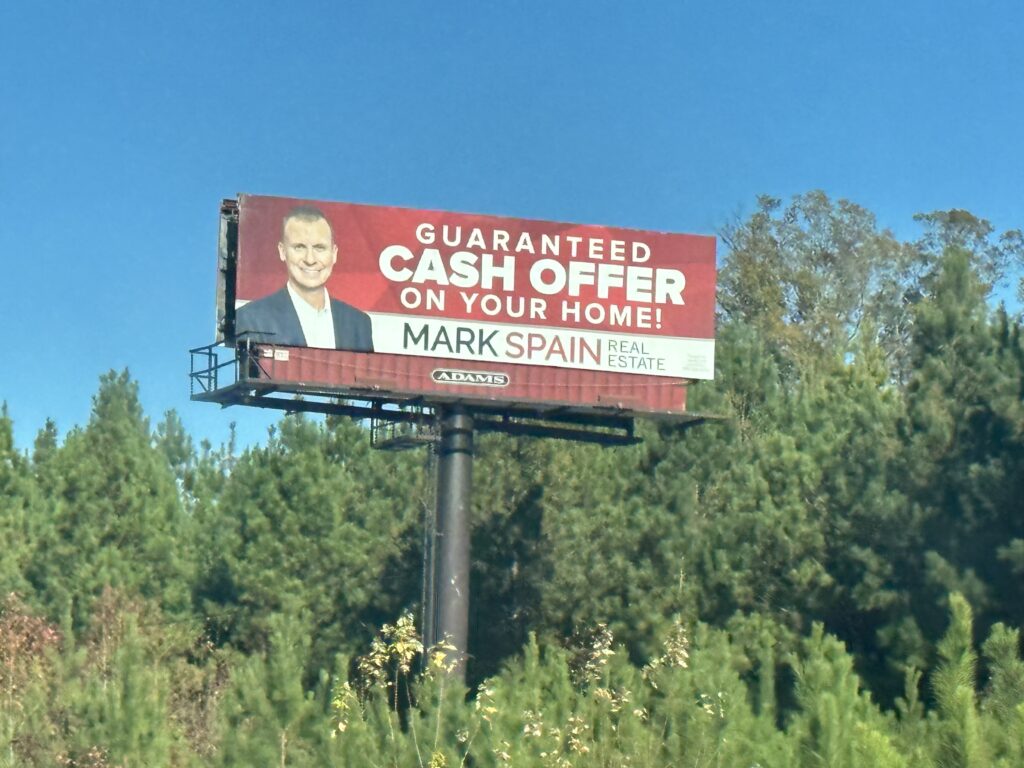
Pest control: “Got bugs. Get Aruza.” I had to look that one up – it’s a pest control company, of course.
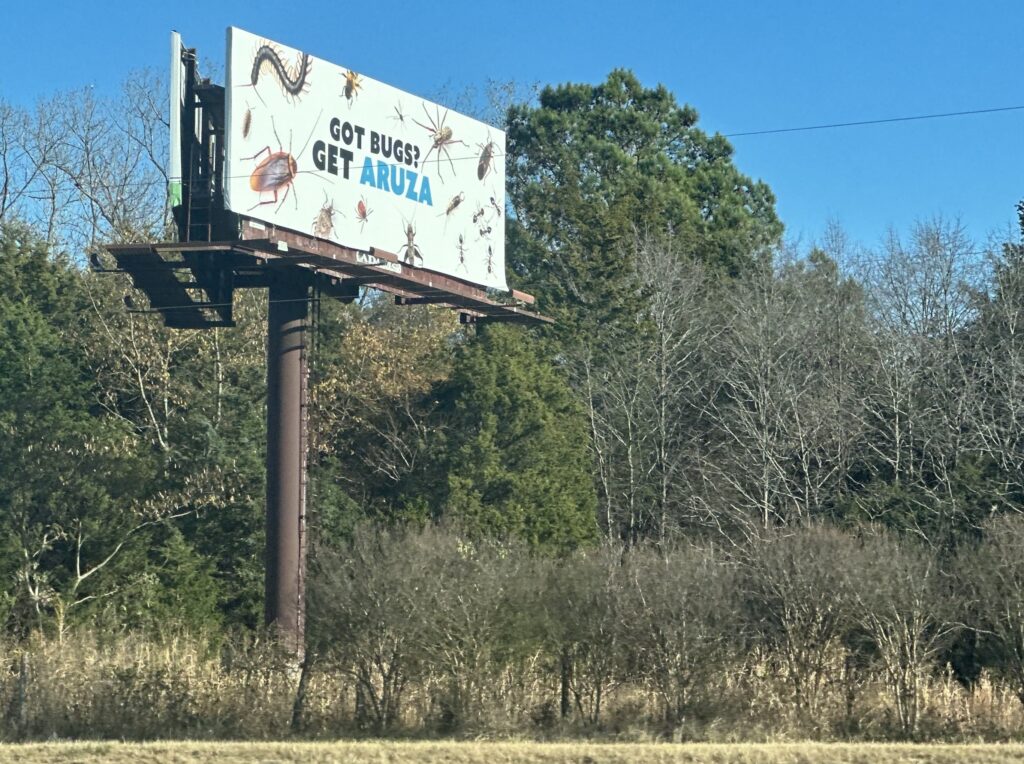
Sex sells on the highway: A full breasted woman who will be “totally nude” plus a “full bar” (I hope so) can be found at the “Southern X-Posure Gentlemen’s Club”; the billboard below it promotes three other clubs at Barboursville, Charleston and Morgantown.” Peterborough closed Thursdays, its last strip club, 14 years ago.
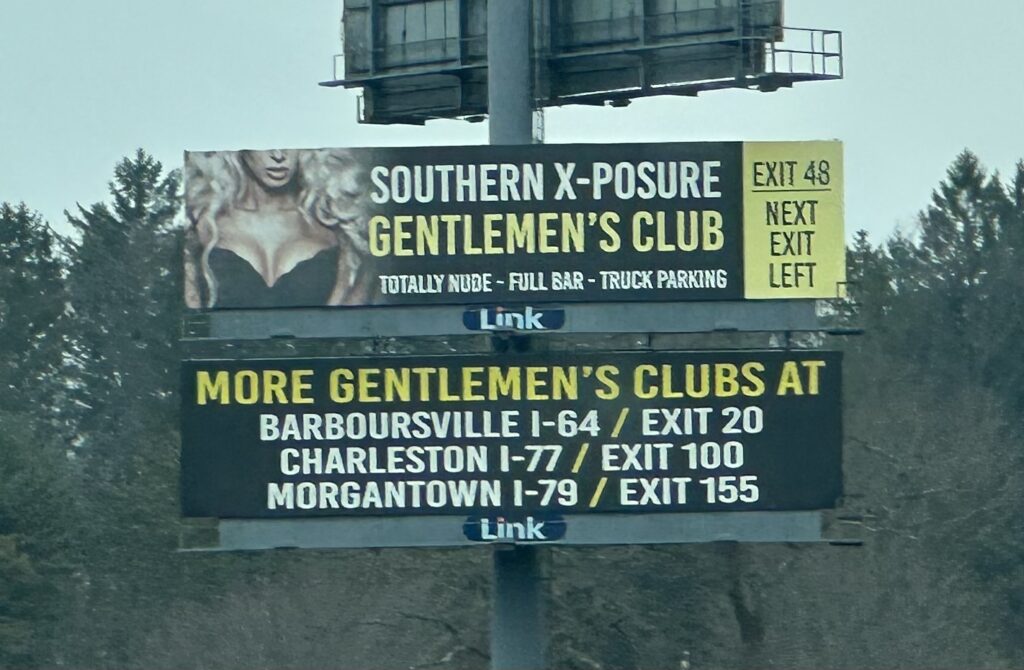
A huge set of rather intimidating red lips help me notice that “lingerie, novelties and movies” can be found at Exit 49A in the Elm Adult Fantasy Store.
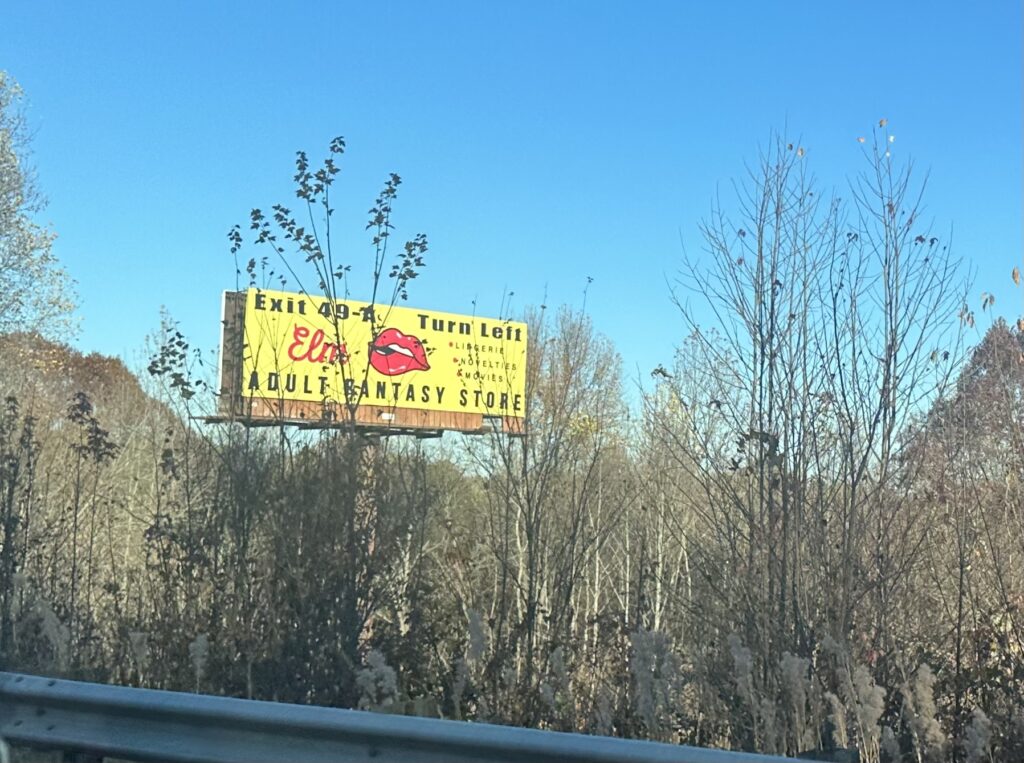
A double sign offers “Pleasure. Passion. Romance at Exit 28” at the “Lion’s Den Adult Superstore”. Choice is what it’s all about on the road. These are big trucker routes, perhaps the main audience.
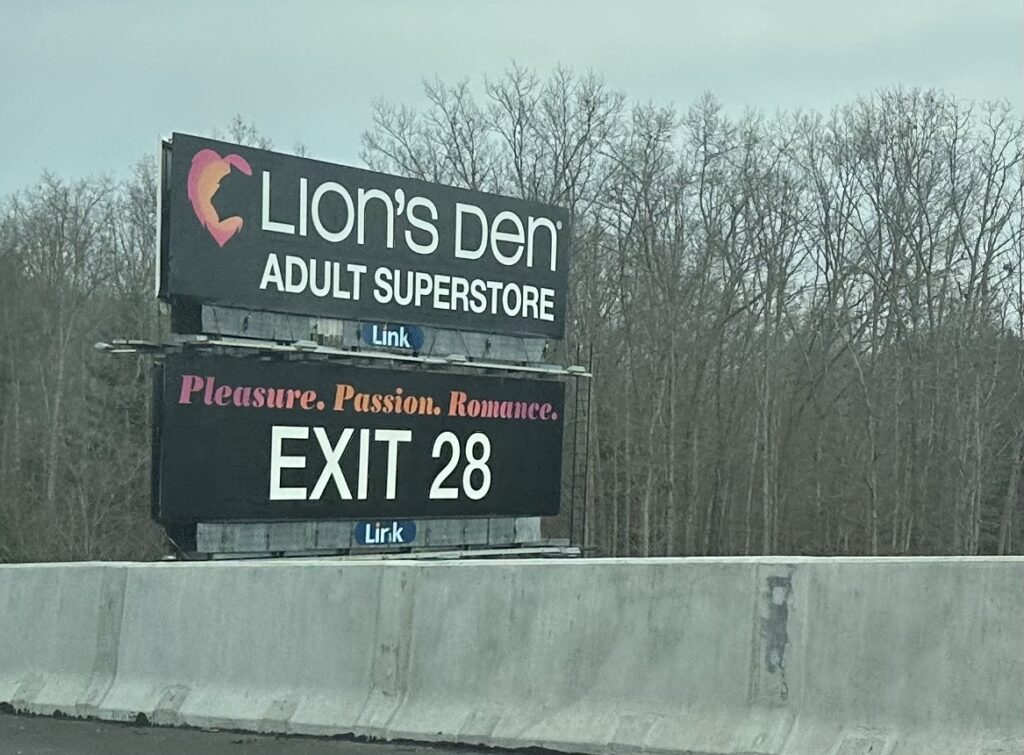
Promotion of the local football team: “Let’s go Panthers” from the official beer partner of the Carolina Panthers (an NFL team out of Charlotte, NC), promoting “Lite – a fine Pilsner”. (It wasn’t until the 1990s that the first beer at a Toronto Maple Leafs game was poured!)
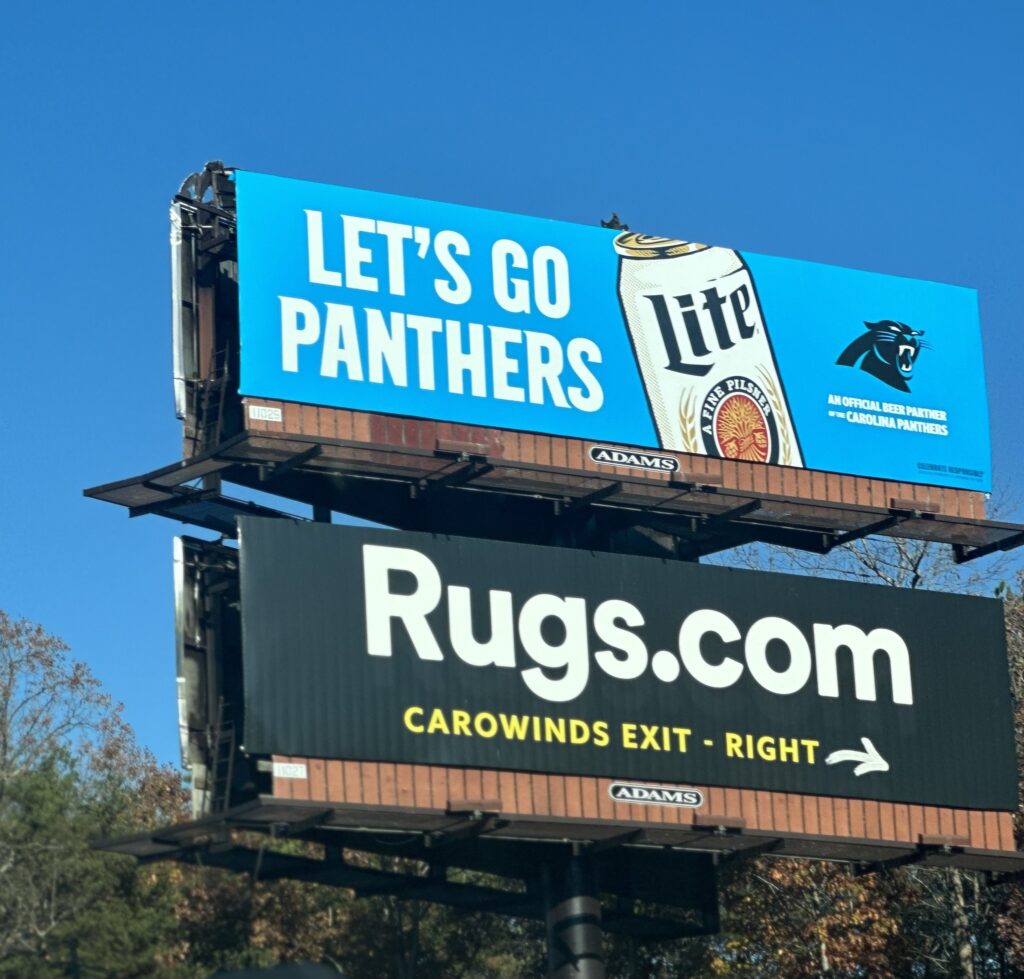
Then came a promo for Dr. Pepper “the one Hornets fans deserve” (being the official soft drink of the Hornets). I had to look that one up; they are the Alabama State Hornets representing Alabama State University, who play football in guess what? Hornet Stadium in Montgomery, Alabama.
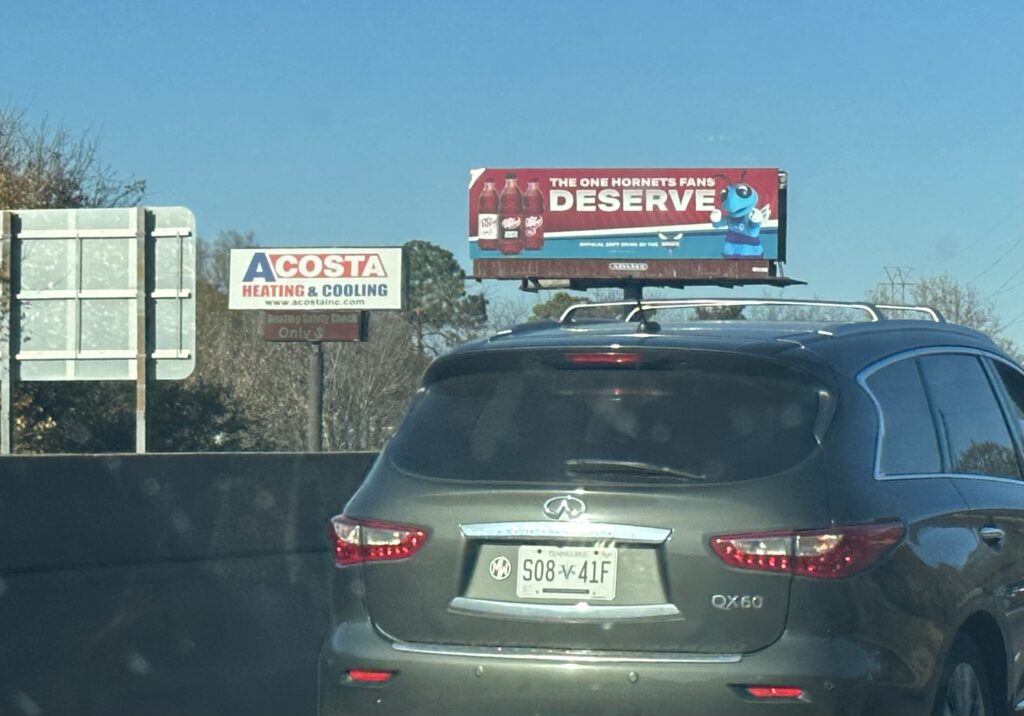
Guns and ammo (who often add “safes” to their offering): All can be found at Nichols Store in Rock Hill 15 minutes south. There are a lot of these stores up and down the throughways, which is no surprise, with American addiction to guns.
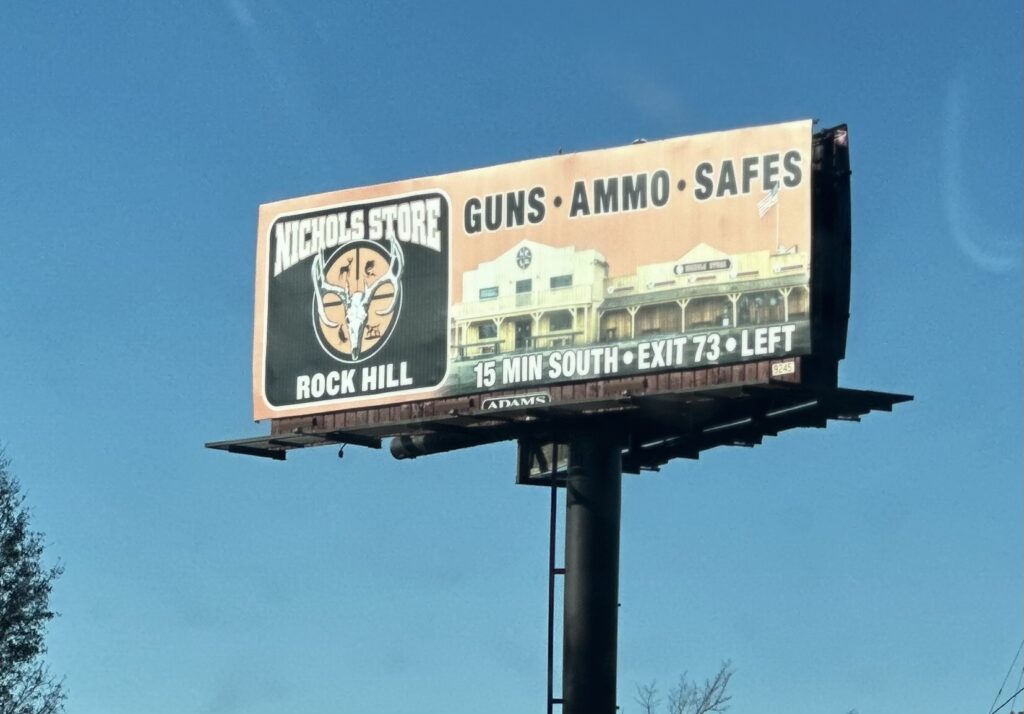
Alcohol and bars: The line “Keep your eyes on the road” at “Hooters, Exit 82C” was plastered over a curvaceous lady in tight yellow shorts. This was right above the public service billboard that states “your clothes that are too small…can do big things for others”).
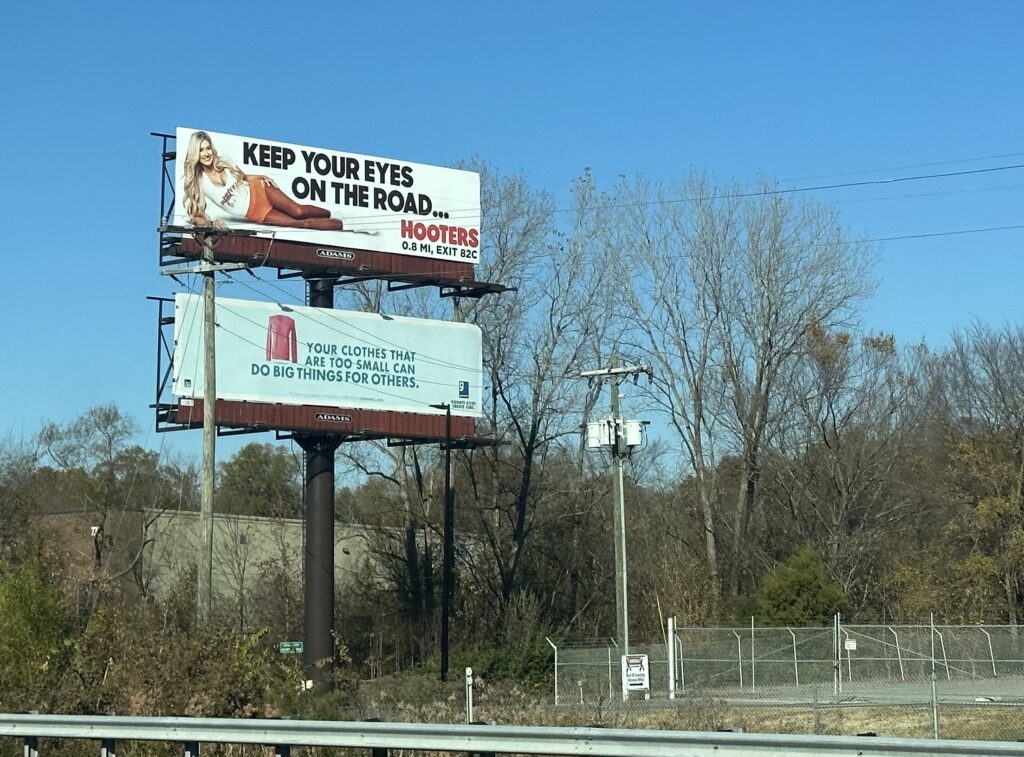
At the other billboard “Southern” promotes the ability to “Sit, Sip, Savor the Moment” meaning “cocktails, tours, and bottle sales” (I can’t imagine what they mean by “tours”). This is not about practicing mindfulness, I’m certain. We didn’t pull off at Exit 54, as they suggested, to find out.
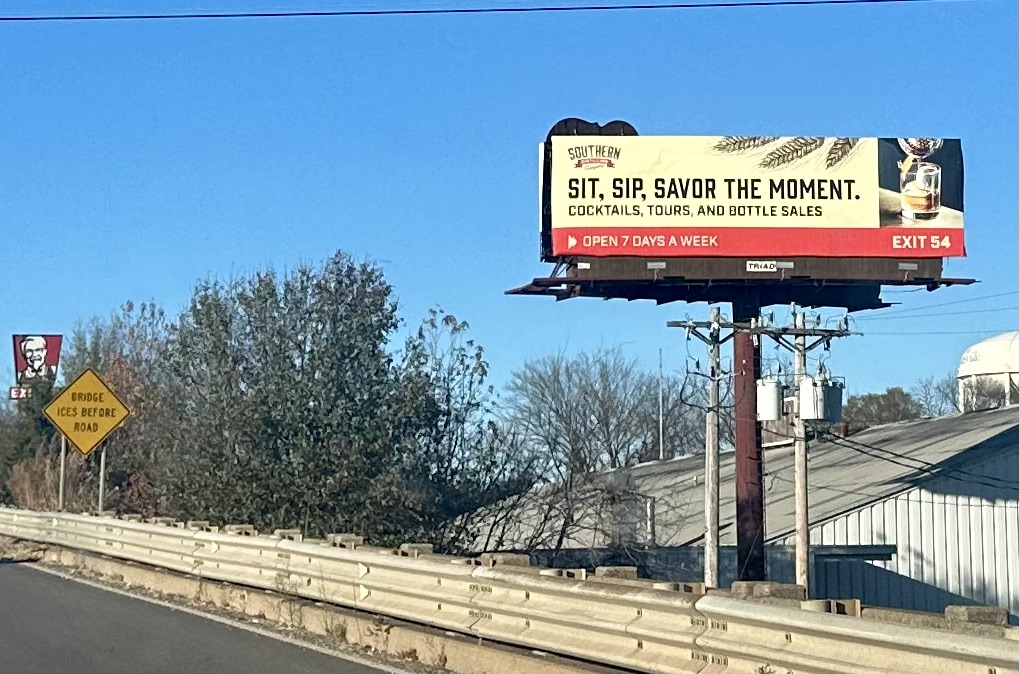
Smokes: We passed many billboards (and establishments) promoting “smokes”. However since 1999, US outdoor advertising formats have not been used to promote cigarette brands, as part of a master settlement between tobacco manufacturers and state attorney generals.
Caveat: This is eastern USA. The states we cruised through include (from south to north): South Carolina, North Carolina, Virginia, West Virginia, Maryland, Pennsylvania, New York. While I have driven across the US in past years I wasn’t as sensitive then to the theme of this blog.
To add an educational twist to this blog, I give you:
History
The history of billboards is intrinsically tied to the history of cars in the United States. It didn’t take long for advertisers to realize these roads and highways were the perfect place to install billboards. As drivers began to use their cars regularly, they would drive by the billboards.
The creation of the Interstate Highway System in the 1950s skyrocketed billboards in America. Billboards became incredibly successful because the Interstate Highway System spanned almost fifty thousand miles, providing advertisers with millions of opportunities.
In 1965, Congress passed the Highway Beautification Act (HBA), which set limitations on the number of billboards that could be placed along highways, along with other regulations on sizing, placement, and even lighting. The HBA:
• Requires states to maintain effective control of outdoor advertising along federal highways
• Regulates billboards within 660ft of federal aid roads
• Prohibits billboards in areas with non-commercial activity
• Prohibits new billboards that don’t conform to certain size, spacing and lighting requirements
As the various billboard associations became more established, they began developing standards for billboard advertising. For instance, in 1889, a twenty-four sheet billboard was unveiled—the first of its kind. This would be the size that became the standard for billboards across the world.
Present
The medium is now changing. Hand painting on a sign became printed paper pasted on the board. Thousands of billboards once lit by four fixtures are switching to two lamps, reducing energy consumption and light spillage.
The next generation of billboards is now digital. Paper and paste is giving way to computer-generated images on plastic substrates.. Digital billboards require less work and deliver more engaging creative to audiences. For instance, with a digital billboard, the material requirements go away. You no longer need to print a massive vinyl canvas, then hire people to install it properly on a billboard display. With digital billboards, all you need is a file you can email to the billboard leasing company. However these tools represent a small fraction of the total number of billboards in the US.
As of 2022, the billboard industry was worth $8.5 billion just in the United States. In 2012 billboards accounted for approximately 2.5% of total U.S. advertising spending.
There are more than 400,000 billboard faces across the US. And as many as 20% are illegal or non-compliant.
Why are they up? Because they work. Billboard advertisers say they would lose 18 percent of sales without billboards.
Billboard advertisements are a form of speech. They are thus protected by the First Amendment to the U.S. Constitution and parallel provisions of state constitutions.
The spacing requirements included in federal/state agreements vary between the states. A majority of the agreements require at least 500 foot spacing on the interstate, 300 feet outside cities, and 100 feet inside cities. Furthermore, spacing requirements can vary according to road classification.
According to Outdoor Advertising Association of America, in 2012 the top users of outdoor advertising included: McDonald’s, Coca-Cola, Verizon, MetroPC, AT&T, CrackerBarrel, Comcast, Samsun, Coors.
Some dissent
There is a non profit called Scenic America’s who has as its mission to preserve and enhance the visual character and scenic beauty of America. They support communities fighting billboard problems and blight. For example 32 states allow outdoor advertising companies to cut down publicly owned trees simply for better billboard visibility.
Billboard owners pay little to no property taxes and no road user fees such as fuel taxes and tolls, yet they derive 100% of their value from their proximity to publicly-funded roads.
A recent study in Philadelphia showed that homes within 500 ft of a billboard are worth $31,000 less at time of sale than those further away.
A 2011 poll of North Carolina voters by Public Policy Polling found that 70% of registered Democrats, 68% of registered Republicans and 78% of registered Independent voters said billboards detracted from community appearance. In the same poll 80% of respondents opposed removing trees to clear views of billboards.
A growing body of evidence demonstrates that digital billboards pose a threat to traffic safety. A study by the Swedish government found that digital billboards took drivers’ eyes off the road for significant periods of time and they subsequently ordered the removal of digital signs. Other studies from Denmark, Canada and Australia show similar concerns about digital billboards’ impact on traffic safety.
A UK pressure group Adfree Cities, wants a complete ban on all outdoor corporate advertising. This would also apply to the sides of buses, and on the London Underground and other rail and metro systems. It has already happened in a few places around the world. As far back as 2006, the Brazilian city of Sao Paulo, the largest in the southern hemisphere, banned all forms of outdoor advertising. Under the so-called Clean City Law, more than 15,000 billboards were subsequently removed, plus 300,000 store signs that were considered to be too large. The French city of Grenoble followed suit in 2014.
Alaska, Hawaii, Vermont and Maine prohibit all billboards. (A 2011 poll by the Portland Press Herald showed that 94% of Mainers opposed a plan to allow billboards back into the state.)
A wonderful way to enjoy the late afternoon on Christmas Eve. Great Joe Ken
Very interesting, Ken.
Thanks and Merry Christmas to you and Penny.
Ken, your blogs, comments, and wry witticisms are always entertaining! Bill
loved the post!
a couple of possible edits …
>>“Prepare to Meet Thy God” (at being saved.org; however that page has been removed from the internet so don’t bother).
but https://beingsaved.org is still online
>>I’m not sure what to make of the subtitle on the billboard which stated “Behold I come quickly”
It is apparently a reference to Revelation 22:12-20
https://www.biblegateway.com/passage/?search=Revelation%2022%3A12-20&version=KJV
Happy New Year!!
Ken
Enjoyed your blog. Hope you and Penny enjoyed your Christmas.
Very best wishes for 2024.
Chris
Ken,
Love the dry wit reflected in your opinions on American culture via the billboard. It was fun to see the world through your eyes.
Many Canadians and Americans feel Canada is identical to the U.S. and is or should be nothing but a 51st state. As your blog clearly points out, Canada is very different and Viva la difference !
Enjoyed the content. You must have missed the Donald Trump signs